Beginner’s Guide to Growing Coreopsis: Easy Care Tips
- March 7, 2024
- 3 comment
Coreopsis, commonly known as Tickseed, is a vibrant and versatile perennial plant that brightens up any garden with its daisy-like flowers. Growing coreopsis is relatively easy and low maintenance, making it an ideal choice for both novice and experienced gardeners. This article provides a comprehensive guide on how to successfully grow and care for coreopsis.
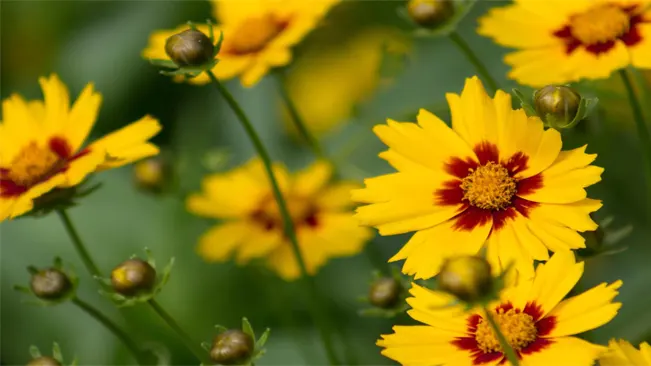
Choosing the Right Variety
Coreopsis comes in various species and cultivars, each with unique characteristics. Popular varieties include Coreopsis grandiflora with its large, bright yellow flowers, and Coreopsis verticillata, known for its delicate, fern-like foliage. Research the varieties available and choose one that suits your climate and garden design.
Coreopsis grandiflora
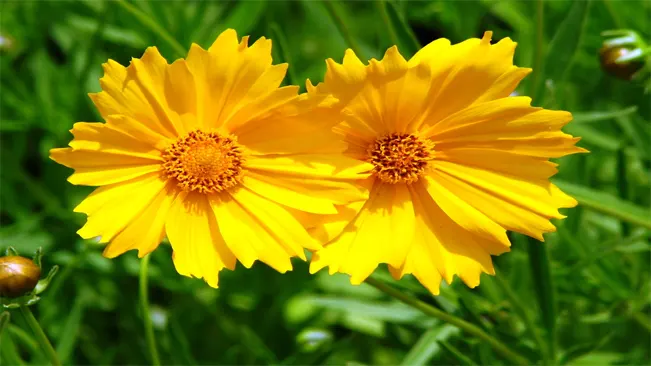
- This species is often referred to as large-flowered tickseed due to its showy, bright yellow blooms. The flowers are typically larger than those of other Coreopsis species, making it a standout in any garden. It blooms from early summer to fall and can reach a height of 1 to 3 feet. This variety prefers well-drained soil and full sun, and it’s known for its tolerance to dry conditions. Popular cultivars include ‘Early Sunrise’, a compact form with double flowers, and ‘Sunray’, which is known for its large, semi-double blooms.
Coreopsis verticillata
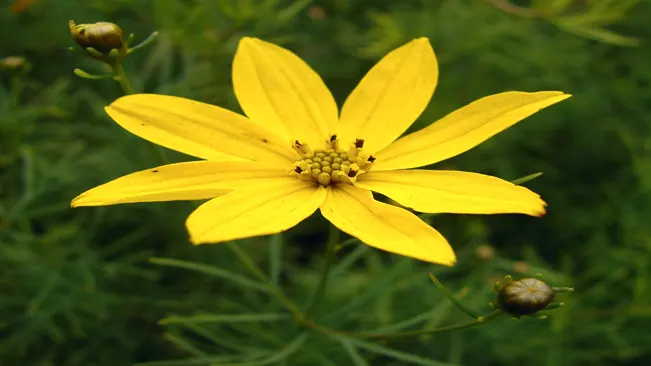
- Known as threadleaf coreopsis or whorled tickseed, this species is celebrated for its fine, needle-like foliage, giving it a delicate, airy appearance. The flowers are typically yellow and smaller than those of Coreopsis grandiflora. This species has a longer blooming period, often from early summer to late fall. It grows about 1.5 to 2 feet tall and prefers full sun and well-drained soil. Notable cultivars include ‘Moonbeam’, with its pale yellow flowers, and ‘Zagreb’, which produces bright yellow blooms.
Coreopsis lanceolata

- Also known as lance-leaved coreopsis, this species is native to North America and features bright yellow, daisy-like flowers. It typically blooms in late spring to early summer and can grow up to 2 feet tall. This variety is easy to care for, drought-tolerant, and prefers full sun and well-drained soil.
Coreopsis tinctoria
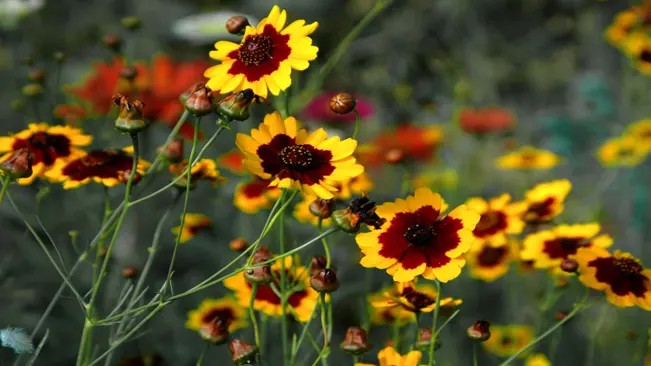
- Commonly called plains coreopsis or golden tickseed, this annual species is known for its vibrant, bi-colored flowers, usually yellow with a maroon center. It’s a prolific bloomer and can add a splash of color to any garden. It grows up to 2 to 3 feet tall and prefers full sun.
Coreopsis auriculata

- Known as lobed tickseed or mouse-ear coreopsis, this species is characterized by its unique flower shape and compact growth habit. It produces bright yellow flowers with a distinctive lobed shape and grows about 1 to 2 feet tall. This variety prefers partial to full sun and well-drained soil.
When choosing a Coreopsis variety, consider the following
- Climate Suitability: Ensure the variety is suitable for your region’s climate.
- Garden Design: Consider the height, color, and blooming period of the Coreopsis variety in relation to your garden design.
- Maintenance Requirements: Some varieties may require more care than others, especially regarding watering and deadheading.
Planting Coreopsis
Timing for Planting Coreopsis
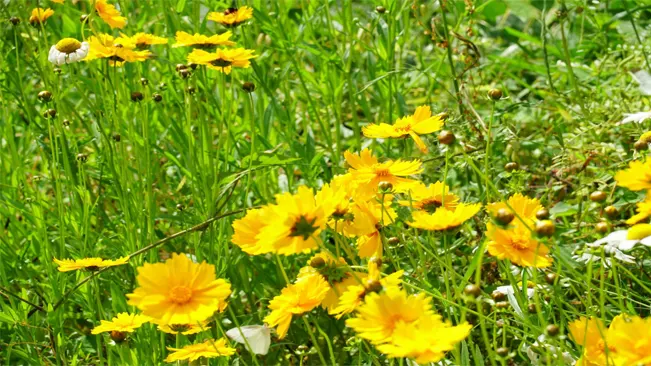
- The timing of planting is crucial for the successful establishment of Coreopsis. The ideal time is in the spring, following the last frost. This timing allows the plant to establish its root system and gain strength before the hot summer months. In regions with milder winters, planting in the fall is also an option. Fall planting allows the roots to establish in the cooler weather, leading to a robust start in the following spring.
Soil Requirements
- Coreopsis isn’t overly fussy about soil types, which is part of its appeal. However, it flourishes best in well-drained soil. Soil that retains too much moisture can lead to root rot and other issues. The ideal soil pH for Coreopsis is slightly acidic to neutral (around pH 6.0 to 7.0). If your garden soil is heavy or clayey, consider amending it with organic matter such as compost to improve drainage. A well-draining soil mix is also essential for container-grown Coreopsis.
Sunlight Needs
- Sunlight is a critical factor in the growth and blooming of Coreopsis. These plants need full sun, meaning they require a minimum of 6 hours of direct sunlight per day. The more sun they receive, the more they will bloom. In partial shade, Coreopsis may grow but with fewer blooms, and the plant may become leggy as it stretches towards the light.
Plant Spacing
- Proper spacing is essential for the health and aesthetic appeal of Coreopsis. Space the plants about 12 to 18 inches apart. This spacing gives each plant enough room to grow and spread without overcrowding, which can lead to issues with air circulation. Good air circulation is vital for preventing fungal diseases and ensuring each plant receives adequate sunlight and nutrients.
Watering and Feeding
Watering Coreopsis
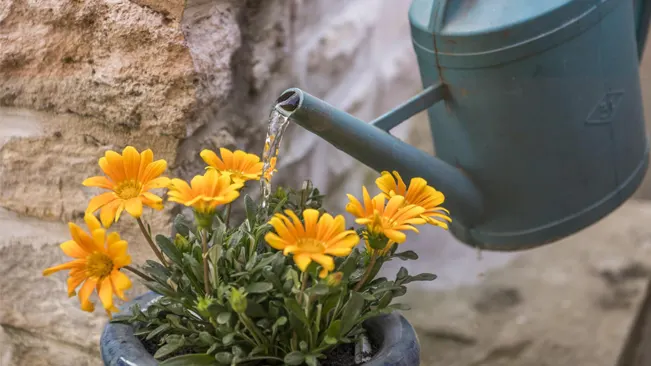
- Initial Watering: When you first plant Coreopsis, it’s important to water them regularly to establish a strong root system. This initial phase is crucial for young plants, as their roots are still developing and need consistent moisture to grow deep and strong.
- Deep Watering Technique: Instead of frequent, shallow watering, opt for deep watering. This means watering the plants thoroughly, allowing the water to penetrate deep into the soil. This method encourages the roots to grow deeper, seeking moisture, which in turn makes the plant more drought-resistant in the long run.
- Checking Soil Moisture: Before watering, check the soil moisture. You can do this by simply sticking your finger into the soil. If the top inch or so of soil is dry, it’s time to water. If it’s still moist, you can wait a bit longer.
- Reduced Watering for Established Plants: Once Coreopsis is established, usually after the first growing season, its watering needs decrease significantly. These plants are quite drought-tolerant and can handle periods of low water. However, during extended dry spells, especially in very hot climates, occasional deep watering may still be necessary.
Feeding Coreopsis
- Limited Fertilization Needs: Coreopsis are not heavy feeders. Over-fertilizing can lead to excessive leaf growth at the expense of flowers. Therefore, a light approach to feeding is best.
- Type of Fertilizer: Use a balanced, slow-release fertilizer. A balanced fertilizer has equal parts nitrogen, phosphorus, and potassium (N-P-K), such as a 10-10-10 formula.
- Timing of Fertilization: The best time to fertilize Coreopsis is in the spring as new growth appears. This gives the plant a nutrient boost at a time when it’s putting out new growth and preparing for the blooming season.
- Method of Application: Follow the instructions on the fertilizer package for the correct amount. Generally, you’ll want to sprinkle the fertilizer around the base of the plants and then water it in. This helps distribute the nutrients into the soil where the roots can absorb them.
Pruning and Maintenance
Deadheading
Why Deadhead Coreopsis?
- Deadheading, or the process of removing spent flowers, is vital for Coreopsis for several reasons:
- It encourages the plant to produce more blooms, leading to a longer flowering period.
- It prevents the plant from using energy to produce seeds, redirecting that energy into more flowers and healthier foliage.
- It keeps the plant looking tidy and aesthetically pleasing.
How to Deadhead Coreopsis
- Regularly inspect your Coreopsis plants and snip off the flower heads as they fade.
- Use clean, sharp scissors or pruners and cut the stem just above a leaf or a new bud.
- Deadheading can be done throughout the blooming season, from early summer to fall.
Pruning
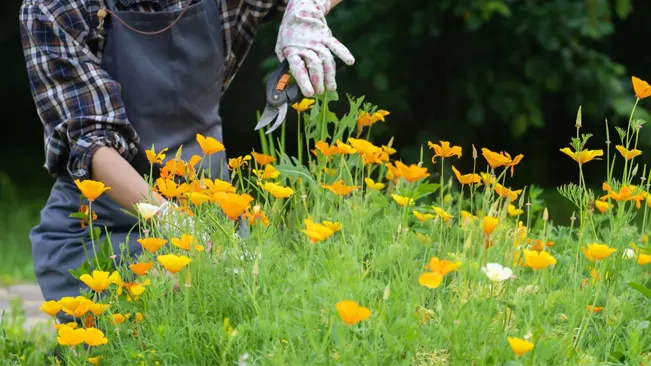
The Benefits of Pruning Coreopsis
- Pruning is different from deadheading; it involves cutting back a significant portion of the plant.
- Early spring pruning is crucial for Coreopsis as it:
- Stimulates new growth leading to a bushier plant.
- Enhances the plant’s overall shape and appearance.
- Encourages a more robust bloom cycle.
How to Prune Coreopsis
- In early spring, just as new growth begins, cut back the entire plant to about 4-6 inches above the ground.
- Use clean, sharp gardening shears for a smooth cut, which is less stressful for the plant.
- Pruning can also be done after the first flush of flowers to rejuvenate the plant and encourage a second blooming.
Dividing Plants
Why Divide Coreopsis?
- Over time, Coreopsis plants can become overcrowded, leading to diminished blooming and potential health issues.
- Dividing helps to rejuvenate older plants, ensuring vigorous growth and plentiful blooms.
- It also controls the spread of the plant, keeping it within bounds in your garden.
How to Divide Coreopsis
- The best time to divide Coreopsis is in early spring or fall when the plant is not in full bloom.
- Gently dig around the plant and lift it from the ground, taking care not to damage the root system.
- Using a sharp spade or knife, divide the plant into smaller sections. Ensure each section has a good portion of roots and several shoots.
- Replant the divisions at the same depth they were growing previously and water them well.
Pest and Disease Management
Coreopsis is generally hardy and resistant to many pests and diseases, but like any plant, it can sometimes encounter problems. Here are some common issues and ways to manage them:
Powdery Mildew
- Description: Powdery mildew is a fungal disease that appears as a white or gray powdery coating on leaves and stems.
- Prevention and Control: Increase air circulation around plants by spacing them properly and pruning if necessary. Ensure the plant receives enough sunlight and consider using fungicides if the problem persists. Using resistant varieties can also be a good preventive measure.
Root Rot
- Description: Root rot can occur in overly moist soil conditions, causing the roots to decay.
- Prevention and Control: Ensure good drainage in the soil and avoid overwatering. If you suspect root rot, you may need to remove affected plants to prevent spread to healthy ones. Planting in raised beds or containers can also help improve drainage.
Aphids
- Description: Aphids are small, soft-bodied insects that suck the sap from the plant, causing damage and potentially spreading diseases.
- Prevention and Control: Encourage natural predators like ladybugs and lacewings. You can also use a strong jet of water to dislodge aphids or apply insecticidal soaps or neem oil for more severe infestations.
Additional Tips for Pest and Disease Management:
- Regular Monitoring: Regularly check your Coreopsis plants for signs of pests or diseases. Early detection is key to effective management.
- Healthy Soil: Maintain healthy soil with adequate organic matter, which can help improve plant health and resistance to pests and diseases.
- Watering Practices: Water the plants at the base to avoid wetting the foliage, as wet leaves can be more susceptible to fungal diseases.
- Crop Rotation: If you’re growing Coreopsis in the same area year after year, consider rotating with different plants to prevent soil-borne diseases.
Winter Care
In colder climates, add a layer of mulch around the base of the plants to protect the roots from freezing temperatures. In milder climates, coreopsis may remain evergreen or semi-evergreen.
- Understanding Hardiness: Coreopsis varieties have different levels of hardiness, generally ranging from USDA hardiness zones 4 to 9. Knowing the specific hardiness zone of your Coreopsis can help you determine the level of winter care needed.
- Mulching: As winter approaches, apply a thick layer of organic mulch around the base of Coreopsis plants. This mulch layer, about 2-3 inches deep, acts as an insulation blanket, protecting the roots from extreme cold and temperature fluctuations. Materials like straw, shredded bark, or fallen leaves are ideal for mulching.
- Watering Before Frost: It’s important to give your Coreopsis a good watering before the ground freezes. This helps to ensure that the plant has sufficient moisture reserves to last through the winter, especially important for newly planted or young plants.
- Trimming Back the Plants: In preparation for winter, you can trim back Coreopsis plants. Some gardeners prefer to leave the dead foliage and stems in place until early spring, as they can provide additional insulation and also habitat for beneficial wildlife. However, trimming them back to ground level after the first hard frost is also a common practice.
- Protection from Severe Cold: In areas with particularly severe winters, additional protection may be needed. This can include covering the plants with a burlap sack or a frost blanket during the coldest spells. Remove these covers when temperatures rise to avoid overheating and moisture buildup.
- Winterizing Container-Grown Coreopsis: If your Coreopsis is in a container, consider moving it to a sheltered location, like a garage or shed, during extreme cold. Containers can freeze more quickly than ground soil, putting the plant at risk.
- Monitoring for Pests and Diseases: Even in winter, keep an eye out for signs of pests or diseases. Healthy plants are more likely to survive the winter and thrive in the spring.
- Spring Assessment: Once winter is over and the signs of spring begin to appear, assess your Coreopsis plants. Remove any dead or damaged parts and start regular watering as the ground thaws.
- Avoiding Early Spring Pruning: It’s often best to wait until you see new growth in the spring before doing any major pruning. This helps to ensure that you don’t accidentally remove any live plant material that can contribute to the new season’s growth.
- Adaptation to Milder Climates: In milder climates where Coreopsis remains evergreen or semi-evergreen, winter care is more about ensuring adequate moisture and less about protection from cold. Still, a light layer of mulch can help to maintain soil moisture and temperature.
Companion Planting
Companion planting with Coreopsis can create a stunning and harmonious garden display. When Coreopsis, known for its bright, cheerful blooms, is paired with other perennials, it not only enhances visual appeal but can also have beneficial effects on the health and growth of your garden. Here’s more about companion planting with Coreopsis:
Lavender
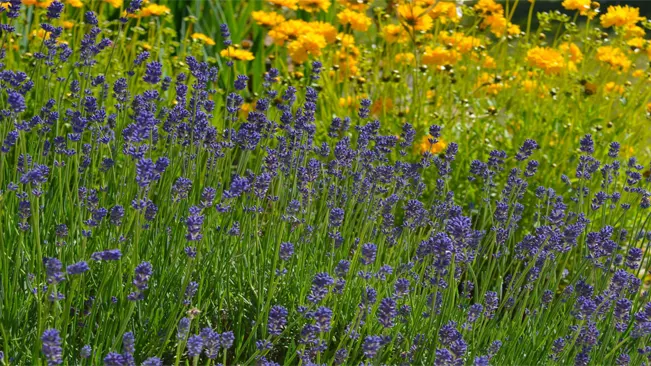
- Lavender, with its fragrant, purple spikes, complements the sunny yellow of Coreopsis. The contrasting colors create a visually striking display. Additionally, lavender’s strong scent can help repel pests, benefiting the Coreopsis.
Salvia
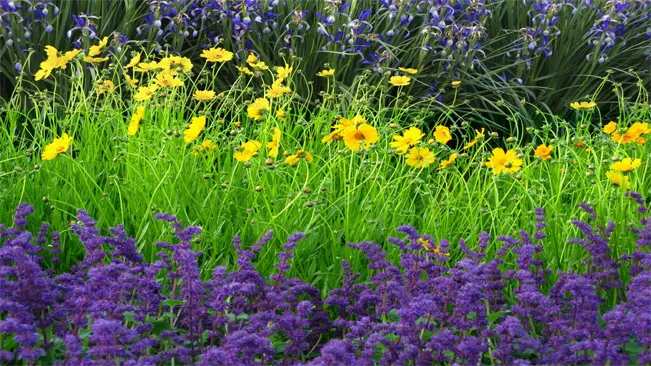
- Salvia, especially the varieties with deep blue or purple flowers, offers a beautiful contrast to the yellow or gold of Coreopsis. Salvia is also a drought-tolerant plant, making it a good match in terms of watering needs. The vertical spikes of Salvia juxtaposed with the daisy-like blooms of Coreopsis can create an appealing texture contrast.
Russian Sage
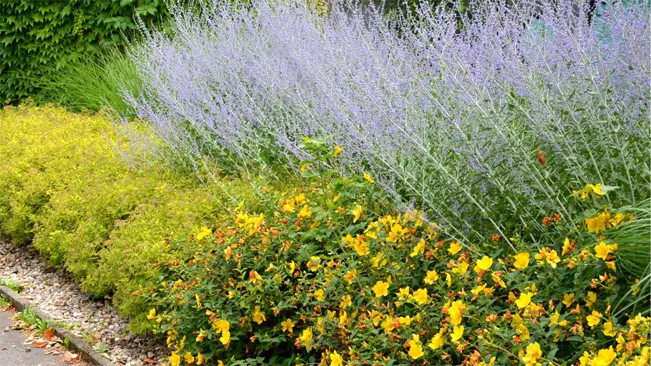
- Russian Sage, with its airy, light blue flowers and silvery foliage, pairs beautifully with Coreopsis. This combination is not only aesthetically pleasing but also thrives under similar growing conditions – both prefer full sun and well-drained soil.
Other Companion Planting Considerations
- Echinacea (Coneflower): The bold, purple-pink blooms of Echinacea complement the yellow of Coreopsis and attract pollinators like bees and butterflies to the garden.
- Sedum (Stonecrop): Sedum varieties, with their succulent leaves and clusters of flowers, offer a different texture and form, making them great companions for Coreopsis.
- Ornamental Grasses: The fine foliage of grasses like Fountain Grass or Blue Fescue can create a soft backdrop for the vibrant Coreopsis flowers.
- Marigolds: The bright orange or red of marigolds can enhance the warm tones of Coreopsis and help deter pests.
- Herbs: Some herbs like thyme and rosemary can also be good companions, as they share similar sun and soil preferences.
Benefits of Companion Planting
- Enhanced Visual Appeal: Companion planting with Coreopsis creates a varied and colorful garden landscape.
- Improved Health and Growth: Certain plant combinations can deter pests and diseases, reducing the need for chemical treatments.
- Attracts Beneficial Insects: A diverse planting attracts pollinators and beneficial insects that help in the pollination of flowers and control of harmful pests.
- Efficient Use of Space: Companion planting can maximize the use of garden space and create a fuller, more lush garden.
Using Coreopsis in Landscaping
Coreopsis, with its vibrant and cheerful blooms, offers a multitude of benefits in landscape design. This versatile perennial is not only visually appealing but also serves as an essential component in creating a thriving ecosystem in your garden. Here’s how Coreopsis can be used effectively in various landscaping scenarios:
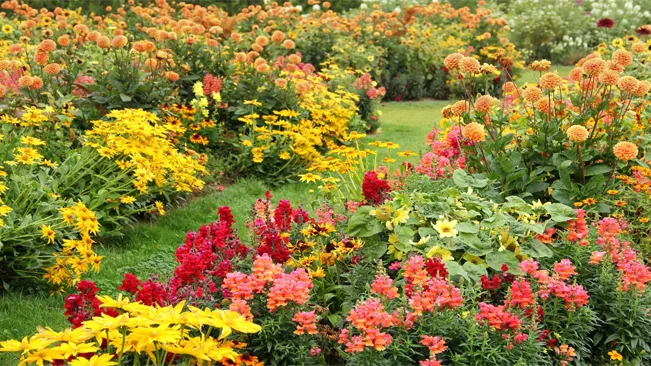
- Border Plantings: Coreopsis is a perfect fit for border plantings due to its medium height and bushy growth habit. When planted along the edges of garden beds or walkways, its bright flowers create a lively and welcoming ambiance. You can mix different varieties of Coreopsis for a varied height and color display, or pair them with other perennials that bloom at different times to maintain a continuous show of color.
- Rock Gardens: The natural, slightly wild look of Coreopsis makes it an excellent choice for rock gardens. Its ability to thrive in well-drained soil complements the typical conditions of a rock garden. Plant Coreopsis amongst the rocks and gravel to add splashes of color and soften the hard edges of the rocks, creating a more harmonious and natural appearance.
- Container Plantings: Coreopsis also does well in containers, making it suitable for patios, balconies, and areas where garden space is limited. When planting Coreopsis in containers, ensure good drainage and place the containers in spots that receive ample sunlight. Combine with other sun-loving plants for a varied and vibrant container display.
- Pollinator Gardens: Beyond its ornamental value, Coreopsis is a magnet for pollinators like bees and butterflies. Including it in a pollinator garden contributes to the health of your local ecosystem by providing these beneficial insects with a valuable food source. Plant Coreopsis amongst other nectar-rich flowers to create a buzzing and beautiful pollinator haven.
- Mass Plantings and Meadows: For a more dramatic effect, consider using Coreopsis in mass plantings. Whether in a large garden bed or a designated meadow area, a sea of Coreopsis creates a stunning visual impact with its waves of golden, pink, or red flowers. This approach is particularly effective in larger landscapes where you want to make a bold statement.
- Seasonal Interest: Coreopsis blooms from early summer to fall, providing long-lasting color in the garden. The variety of colors and forms available means you can choose Coreopsis that complements your garden’s color scheme and extends visual interest throughout the growing season.
- Companion Planting: In terms of companion planting, Coreopsis pairs well with other perennials such as Echinacea (Coneflower), Lavender, and Salvia. These combinations not only enhance visual appeal but also support a diverse range of wildlife.
Conclusion
In conclusion, coreopsis is a delightful addition to any garden due to its easy-care nature and vibrant flowers. By following these guidelines, you can enjoy the beauty of coreopsis blooms throughout the growing season. Remember, gardening is an art that requires patience and experimentation, so feel free to adapt these tips to suit your specific gardening environment.
FAQs (Frequently Asked Questions)
1. What is the best time to plant Coreopsis?
Coreopsis should be planted in the spring after the danger of frost has passed. In warmer climates, they can also be planted in the fall.
2. How much sunlight does Coreopsis need?
Coreopsis thrives in full sun. It needs at least 6 hours of direct sunlight each day for optimal growth and blooming.
3. What type of soil is suitable for Coreopsis?
Coreopsis prefers well-drained soil. While it can tolerate a variety of soil types, a slightly acidic to neutral pH is ideal.
4. How often should I water Coreopsis?
Water Coreopsis regularly during its first growing season to establish a deep, extensive root system. Once established, it is drought tolerant and requires less frequent watering.
5. Does Coreopsis need fertilizer?
Coreopsis generally does not require a lot of fertilizer. A light application of a balanced, slow-release fertilizer in the spring is sufficient.
6. How do I encourage Coreopsis to re-bloom?
Deadheading, or removing spent flowers, encourages the plant to produce more blooms. This can extend the flowering period throughout the summer.
7. When and how should I prune Coreopsis?
Prune Coreopsis in early spring by cutting back the plants to about 4-6 inches. This encourages bushier growth and more flowering.
8. Are Coreopsis plants prone to pests or diseases?
Coreopsis is relatively pest and disease-resistant. However, they can occasionally be affected by powdery mildew, root rot, and aphids. Good air circulation and proper watering practices can help prevent these issues.
9. Can Coreopsis survive winter?
In colder climates, Coreopsis should be mulched in the fall to protect the roots from freezing. Some varieties may die back in winter and re-sprout in spring, while others can remain evergreen in milder climates.
10. How do I propagate Coreopsis?
Coreopsis can be propagated by dividing the plants every few years. This is best done in early spring or fall. You can also grow Coreopsis from seeds, either sown directly in the garden or started indoors.

Kristine Moore
Forestry AuthorI'm Kristine Moore, a seasoned garden landscaping professional with over 30 years of experience. My extensive career has been dedicated to transforming outdoor spaces into stunning, sustainable landscapes. With a deep understanding of horticulture, design principles, and environmental stewardship, I have become a respected figure in the field, known for creating harmonious, visually appealing, and eco-friendly gardens. My commitment to excellence and continuous learning in landscaping trends and techniques has solidified my reputation as an expert in garden design and implementation.
3 comments
Seeds planted approx 8wks ago, bought from RHS end 2023, in constantly warm greenhouse, using seed compost, still NO growth. Any hope?
Hilarie Grace Burnett
June 1, 2024 7:38 pmThis was very informative. I appreciate how thorough the information is considering every season and sunlight.






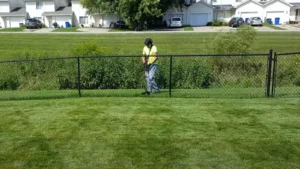




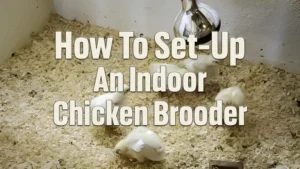

Can I trim and shape my coreopsis with the buds on the stems but not opened in June? It is very bushy and needs to be rounded out. Or do I have to wait for the flowers to dry up and trim when I deadhead in July?
Wendy
June 5, 2024 9:32 pm